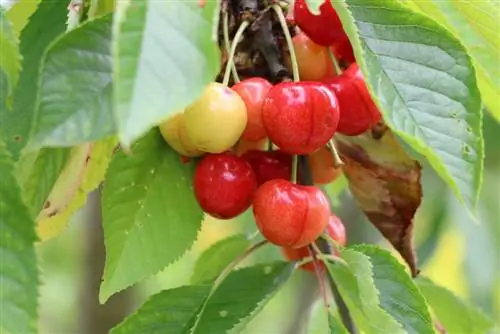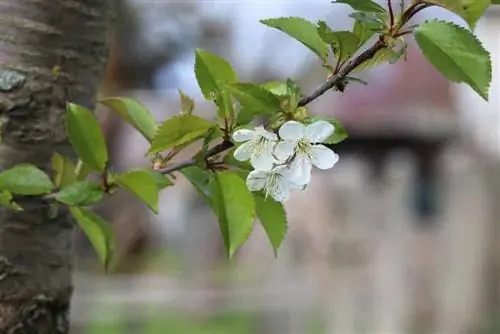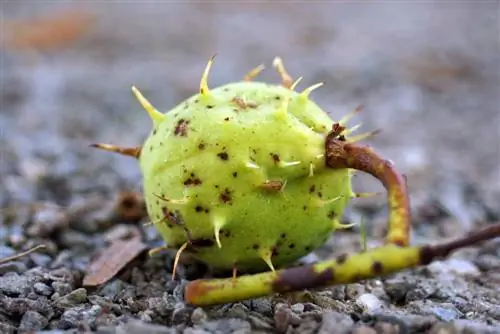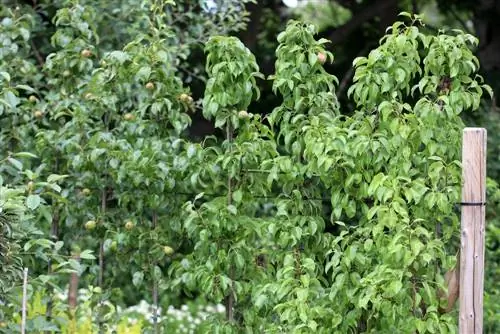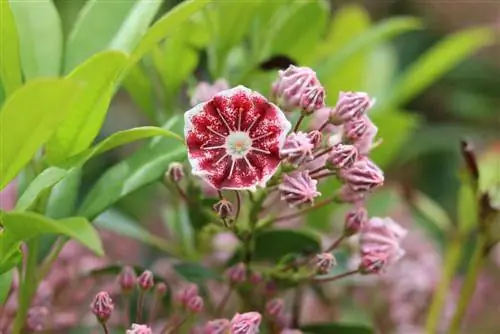- Author admin [email protected].
- Public 2023-12-17 03:39.
- Last modified 2025-01-24 12:45.
Small fruit trees bear less fruit than large ones. To a certain extent, this is in the nature of things and is a question of logic. But of course a fruit lover who has to use dwarf fruit trees for reasons of space also wants to harvest as many fruits as possible. For this to work, two factors are particularly important. On the one hand, you should choose the highest-yielding varieties possible right from the start. On the other hand, an optimal location and optimal care play a central role - regardless of whether the dwarf fruit tree is in the garden or on the balcony.
Varieties
If the yield of a dwarf fruit tree is particularly important to you, you can make important preliminary decisions when purchasing the tree. It starts with what type of fruit you want to harvest. Large fruits such as apples and pears naturally produce low yields from dwarf fruit trees. So if you value a rich harvest, you should choose trees with small fruits. First of all, there are of course cherries and sour cherries, which you can snack on straight from the branch. But plums, plums, peaches and nectarines are also available. If you don't want to do without apples and pears, we recommend the following varieties, which promise higher yields:
- Pillar Apple Redcats
- Pillar Apple Goldcats
- Dwarf apple Galina
- Pillar Bulb Condo
- Dwarf pear Luisa
When it comes to the rather small fruits, these varieties promise a good to very good yield:
- Dwarf Cherry Regina
- Dwarf Cherry Stella Compact
- Dwarf Cherry Griotella
- Dwarf sour cherry Morellini
- Plum Marika
- Plum plum Geisenheimer Top
- Dwarf Peach Amber Pix Zee
- Dwarf Peach Bonanza
In principle, you shouldn't expect a mass harvest from these somewhat higher-yielding varieties. The dwarf fruit trees and bushes are simply not made for this. For example, it may well be possible that a columnar plum produces just enough fruit when harvested to be enough for one or at most two cakes.
Tip:
To increase the yield of a dwarf fruit tree, always pay attention to the best possible location and give it the best possible care.
Location
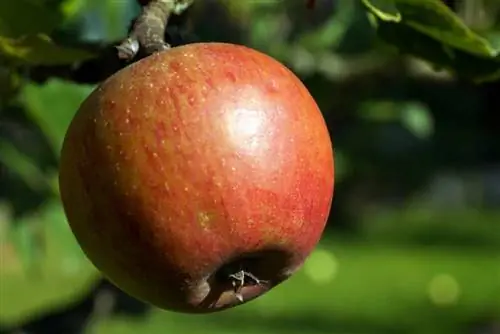
A dwarf fruit tree will usually produce a large yield of fruit if the living conditions are right for it. Of course, important factors such as the weather or the flight of bees cannot be influenced, but there are a few things you can do to make the tree feel really comfortable. This starts with choosing the right location. All fruit trees, whether they are large or small, love sunny and warm temperatures. A sunny, protected location is therefore absolutely necessary. However, the trees definitely do not like shade or partial shade. Also important: dwarf fruit trees are significantly more susceptible to night frosts in spring. Even in an otherwise sunny location, it may be necessary to cover the base above the roots with conifers to protect the root system from the cold.
Care
Good care has a positive effect on the growth and he alth of the dwarf fruit tree. This in turn significantly increases the chances of a good harvest. Three factors play a special role in the care of dwarf fruit trees:
- the water supply
- nutrient supply
- the cut
Dwarf fruit trees need a lot of water to thrive and ultimately bear fruit. At the same time, they cannot tolerate waterlogging. Especially if the trees are grown in a planter, it is important to ensure that excess water can drain away easily. To ensure this, we definitely recommend a pebble insert in the planting substrate. When keeping containers, the nutrient supply is ensured by regularly adding compost. Sand in the soil also ensures that the plant gets the minerals it needs. Finally, the cut. Fruit trees are pruned to give them a certain shape, but also to ensure good growth and yield. Dwarf fruit trees should therefore be pruned regularly throughout the season. The following applies: Always only cut directly above a bud and under no circumstances cut branches with fruit buds.
Cultivation in the bucket and on the balcony
The special appeal of dwarf fruit trees is that they can not only be cultivated outside in the garden, but also in a planter. He can then stand with the tree on the terrace or balcony. Consequently, this makes it possible for people who do not have their own garden to grow their own fruit. Cultivation in a bucket is possible without any problems, but requires more maintenance. In addition, the location on the balcony or terrace must be right - especially if you want to harvest as much fruit as possible. It is therefore important that the balcony definitely be on the sunny side of the house. In addition, the masonry should only cast little shadow. It is also forbidden to extend an awning for a longer period of time. The following points must also be taken into account for successful and profitable cultivation of dwarf fruit trees in a planter:
- choose a sufficiently large planter with a minimum capacity of 30 liters
- fill in a very nutrient-rich substrate with clay, sand, compost and pebble insert
- When planting, be careful not to damage the roots
- water regularly, the soil should be slightly moist but not wet
- Avoid waterlogging at all costs
- fertilize regularly with compost from March to August
- Repot the tree after five years at the latest
When placing it on the balcony or terrace, you should also ensure that the dwarf fruit tree cannot fall over. This can happen relatively easily due to a gust of wind. Falling over can cause significant damage to the branches and thus have a negative impact on growth and harvest.
Tip:
The chances of a good harvest increase with the size of the planter. The following applies: the bigger it is, the more the tree will feel like it is coming from.
Conclusion
The combination of varieties that bear relatively well, the ideal location and optimal care should generally mean that a satisfactory harvest can be achieved even with a dwarf easter tree. However, you should always be aware that mass alone cannot be the goal. If you rely on large quantities, you definitely can't avoid growing conventional fruit trees in your own garden. However, for everyone who simply enjoys harvesting their own fruit and snacking directly from the tree on the balcony, the dwarf fruit tree is undoubtedly a clever alternative. It's definitely more fun than buying fruit in the supermarket. In addition, the cultivation of dwarf fruit trees is also good preparation, should you perhaps be one of the lucky ones who has your own large garden with a meadow orchard.

